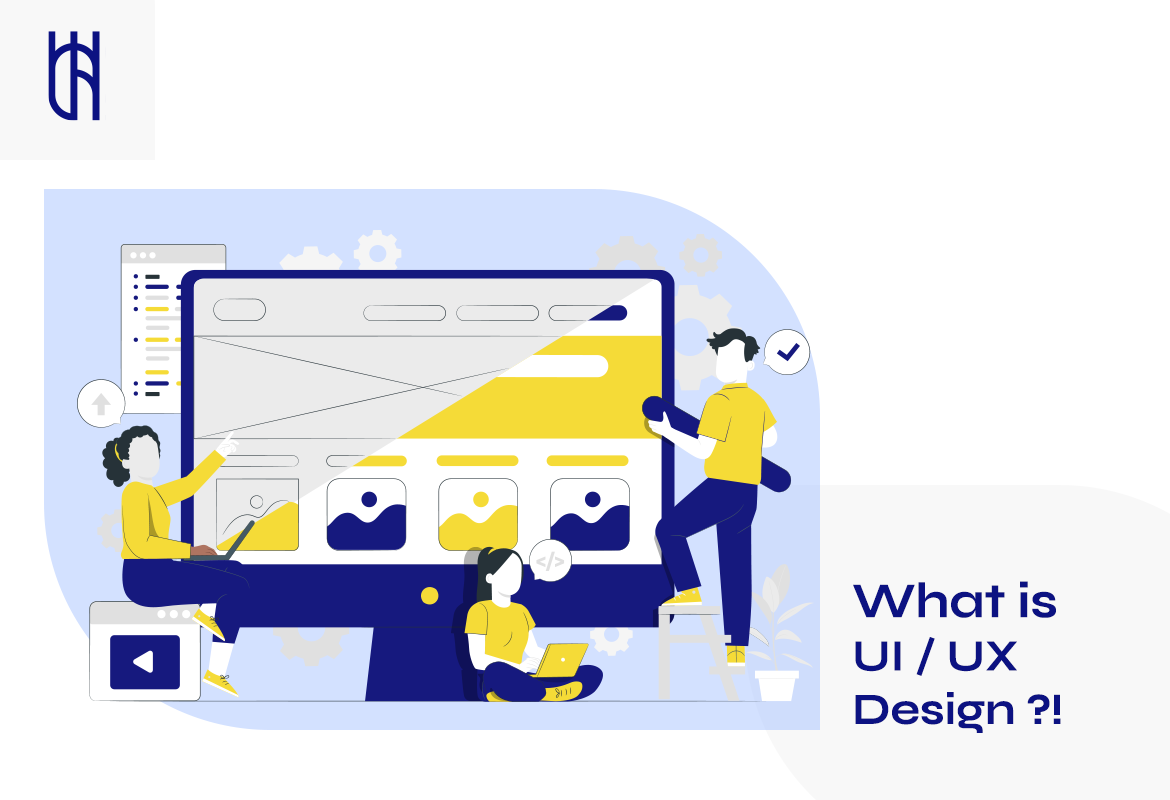UI and UX Design
The significance of UI and UX design has surged as businesses strive to provide customers with streamlined, intuitive, and engaging online experiences. At the crossroads of aesthetics and functionality lies the work of UI/UX designers – the architects of digital landscapes. This piece outlines the essentials of UI/UX design, delineating roles, tools, principles, and the distinction between UI and UX.

What is User experience (Ux) Design?
UX design is all about understanding the user’s needs and aspirations to deliver a product that’s not just functional but also delightful to use. It involves a deep knowledge of users, a keen eye on competition, and a passion for solving design problems.
The primary goal of UX design is to create meaningful and satisfying experiences for users by understanding their needs, preferences, and pain points. This involves conducting user research, gathering insights, and identifying user personas to gain a deep understanding of the target audience. UX designers then use this information to inform the design process and make informed decisions about the structure, layout, and functionality of the product.
UX design include:
- User Research: Gathering qualitative and quantitative data to understand user behavior, preferences, and pain points.
- Information Architecture: Organizing and structuring content and features in a way that is intuitive and easy for users to navigate.
- Wireframing and Prototyping: Creating low-fidelity wireframes and high-fidelity prototypes to visualize and test the user interface and interaction flow.
- Usability Testing: Conducting user testing sessions to gather feedback and identify areas for improvement in the design.
- Iterative Design: Continuously refining and iterating on the design based on user feedback and testing results to ensure a user-centered approach.
UX design aims to create products and services that are not only functional and usable but also delightful and enjoyable to use. By prioritizing the needs and experiences of users, UX designers play a crucial role in driving user satisfaction, engagement, and loyalty.

What is User interface (Ui) Design?
UI Design is the process of making interfaces visually appealing, coherent, and efficient for users. It deals with the graphical layout of an application, including buttons users click on, text they read, images, sliders, and all other items the user interacts with.
UI designers are responsible for crafting the look and feel of digital products, including the arrangement of elements on the screen, color schemes, typography, icons, buttons, and other graphical assets. They ensure that the interface elements are aesthetically pleasing and effectively communicate information to users.
UI design include:
- Visual Design: UI designers create visually appealing interfaces by choosing appropriate color palettes, typography, and graphical elements that align with the brand identity and enhance the user experience.
- Layout Design: They design the layout of interface elements, such as navigation menus, content sections, and interactive elements, to ensure logical organization and easy navigation for users.
- Interactive Design: UI designers design interactive elements, such as buttons, forms, sliders, and animations, to provide feedback and guidance to users as they interact with the interface.
- Consistency: Consistency in design elements across different screens and pages helps users understand and navigate the interface more easily. UI designers maintain consistency in layout, color schemes, typography, and interaction patterns throughout the digital product.
- Accessibility: UI designers ensure that the interface is accessible to users with disabilities by adhering to accessibility standards and guidelines, such as providing alternative text for images and ensuring sufficient color contrast.
UI design plays a crucial role in creating visually appealing and user-friendly digital interfaces that effectively communicate information, engage users, and contribute to the overall success of digital products and services.
What is the difference between UI,UX design ?

ui vs ux .. User Interface (UI) design and User Experience (UX) design are closely related disciplines that work together to create digital products and services. While they are often used interchangeably, they represent different aspects of the design process:
-
User Interface (UI) Design:
- UI design focuses on the visual and interactive elements of a digital interface.
- It involves designing the layout, aesthetics, and interactive components of the interface, such as buttons, forms, menus, and icons.
- UI designers are responsible for creating visually appealing and intuitive interfaces that effectively communicate information and guide users through their interactions with the product.
- UI design primarily deals with the look and feel of the interface, including color schemes, typography, graphical elements, and overall visual aesthetics.
-
User Experience (UX) Design:
- UX design focuses on the overall experience of using a product or service.
- It involves understanding user needs, behaviors, and motivations to design products that are intuitive, usable, and delightful.
- UX designers conduct user research, create user personas, develop user journeys, and define information architecture to ensure that the product meets user needs and goals.
- UX design encompasses the entire user journey, from initial discovery and interaction with the product to the completion of tasks and achieving desired outcomes.
- UX design aims to optimize the overall user experience by identifying pain points, removing barriers to usability, and enhancing user satisfaction and engagement.
While UI design deals with the visual and interactive aspects of a digital interface, UX design focuses on the holistic experience of using a product or service. Both disciplines are essential for creating successful digital products that meet user needs, drive engagement, and achieve business objectives.
What is the outcome of UI UX?
The result of using UI/UX design is the creation of digital products and services that deliver exceptional user experiences, driving user satisfaction, engagement, and ultimately, business success. Here are some specific outcomes of employing UI/UX design:
1.Enhanced User Satisfaction: By focusing on user needs, behaviors, and preferences, UI/UX design ensures that digital products and services are intuitive, easy to use, and enjoyable. This leads to higher levels of user satisfaction and loyalty.
2.Improved User Engagement: Well-designed interfaces and seamless user experiences captivate users’ attention and encourage them to interact more deeply with the product or service. This increased engagement can lead to longer session durations, higher conversion rates, and increased customer retention.
3.Increased Usability: UI/UX design aims to eliminate friction points and obstacles in the user journey, making it easier for users to accomplish their tasks and achieve their goals. This results in improved usability and efficiency, reducing user frustration and abandonment rates.
4.Higher Conversion Rates: A user-centric design approach can lead to higher conversion rates by guiding users through the desired actions and optimizing the conversion funnel. Clear calls-to-action, intuitive navigation, and persuasive design elements can all contribute to increased conversions.

5.Brand Loyalty and Advocacy: Positive user experiences create strong emotional connections between users and brands, fostering brand loyalty and advocacy. Users who have a positive experience are more likely to recommend the product or service to others and remain loyal customers over time.
6.Competitive Advantage: In today’s competitive landscape, UI/UX design can serve as a key differentiator for businesses. Products and services that prioritize user experience stand out from the competition and attract more customers, gaining a competitive advantage in the market.
7.Business Growth: Ultimately, the result of effective UI/UX design is business growth. Satisfied users are more likely to become repeat customers, leading to increased revenue and profitability. Additionally, positive word-of-mouth referrals and brand advocacy can drive organic growth and expansion opportunities for businesses.
The result of using UI/UX design is the creation of digital experiences that prioritize user needs, deliver value, and drive business success. By investing in UI/UX design, businesses can create products and services that resonate with users, foster loyalty, and generate sustainable growth over time. to know more about What is the difference between UX and UI design and the programs used? Click Here
خاتمة
While UI (User Interface) design focuses on the visual elements and interactive aspects of a product, UX (User Experience) design emphasizes the overall feel, functionality, and ease of use. UI design is about creating aesthetically pleasing and intuitive interfaces, whereas UX design aims to enhance the user’s journey through research, prototyping, and testing. Together, they work to create cohesive, user-centered products that are both functional and enjoyable to use. The كودستان website can help you achieve this by providing expert UI/UX design solutions tailored to meet your business goals and enhance user satisfaction.
التعليمات
What is User Experience (UX) Design?
UX design is all about understanding the user’s needs and aspirations to deliver a product that’s not just functional but also delightful to use. It involves a deep knowledge of users, a keen eye on competition, and a passion for solving design problems.
What is User Interface (UI) Design?
UI design focuses on making interfaces visually appealing, coherent, and efficient for users. It deals with the graphical layout of an application, including buttons, text, images, sliders, and all other elements users interact with.
What is the Difference Between UI and UX Design?
UI Design: Focuses on the visual and interactive aspects of a digital interface, creating the layout, aesthetics, and interactive elements like buttons, forms, menus, and icons.
UX Design: Centers on the overall experience of using a product or service, understanding user needs and motivations, and optimizing the user journey.
Together, they work to create user-centered products that are visually appealing, functional, and delightful to use.
How can CodeStan help with UI/UX design?
At CodeStan, we offer comprehensive UI/UX design services that include research, wireframing, prototyping, and testing to ensure a seamless and user-friendly experience for your digital products.




